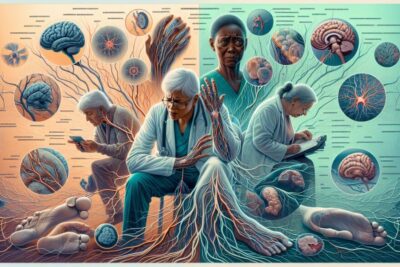
Living with painful diabetic neuropathy can be a daily struggle, with persistent pain impacting every facet of life. However, groundbreaking treatments are emerging, offering new hope for those affected. Among these, the High-Frequency 10 kHz Spinal Cord Stimulation stands out as a beacon of relief.
Presented by the esteemed American Diabetes Association, this innovative therapy promises not just pain management, but also an enhanced quality of life. Let's delve into the nuances of this revolutionary treatment and its pathophysiological impact on those suffering from diabetic nerve pain.
🔍 Seeking a breakthrough in Type 2 Diabetes management?
Discover our expert insights and innovative approaches on ‘How to Cure Diabetes’.
Click to transform your health journey today!
What you\'ll find in this article?
- What Is High-Frequency 10 kHz Spinal Cord Stimulation?
- How Does 10 kHz Spinal Cord Stimulation Improve Quality of Life?
- Nevro's Clinical Trial Results
- Real-World Analysis of 10 kHz Spinal Cord Stimulation
- Potential Benefits of 10 kHz Spinal Cord Stimulation for Diabetic Neuropathy
- Comparing Conventional Medical Management with 10 kHz SCS
- Related Questions on High-Frequency Spinal Cord Stimulation
What Is High-Frequency 10 kHz Spinal Cord Stimulation?
Spinal cord stimulation (SCS) is not a novel concept, yet its high-frequency 10 kHz iteration presents a modern approach to chronic pain management. This therapy involves the delivery of electrical signals to the spinal cord, which can mitigate the pain signals being sent to the brain.
In the context of diabetic neuropathy, where nerve damage causes severe pain, the Nevro HFX™ technology has been a game-changer. It operates at a frequency of 10 kHz, which has been shown to be particularly effective in alleviating discomfort without the paresthesia associated with lower-frequency SCS.
The system is comprised of a small implanted device that generates these high-frequency impulses, managed by the patient to suit their individual pain management needs.
Explore our specialized services in diabetes care 🌟.
From personalized diet plans to effective exercise routines, we have what you need to take control of Type 2 Diabetes.
Visit our services page now!












How Does 10 kHz Spinal Cord Stimulation Improve Quality of Life?
Those grappling with diabetic neuropathy often report a diminished quality of life due to constant pain. The 10 kHz SCS therapy, however, has been linked with notable improvements in this area.
Pain reduction is just the tip of the iceberg. Patients have reported enhanced mobility, improved sleep patterns, and a general increase in the ability to partake in daily activities without the burden of pain.
Moreover, this form of SCS not only manages pain but also addresses the underlying pathophysiological impact of neuropathy, potentially slowing the progression of nerve damage.
Nevro's Clinical Trial Results
The SENZA Painful Diabetic Neuropathy Randomized Controlled Trial presented by Nevro Corp. has shed light on the efficacy of this treatment. Over a span of 24 months, participants witnessed significant pain reduction, coupled with a decrease in HbA1c levels and body weight. These results underscore the dual benefit of pain management and improvement in diabetes management.
A closer look at the trial results also reveals sensory improvements, which hint at a restorative effect on nerve function, a finding that could have far-reaching implications for the treatment of diabetic neuropathy.
Real-World Analysis of 10 kHz Spinal Cord Stimulation
The clinical trial is not the only source of positive results. Real-world data echo the trial's findings, with a high percentage of patients experiencing over 50% pain relief. These outcomes were not limited to pain alone; improvements were also seen in functional abilities and sleep quality.
This data not only supports the use of 10 kHz SCS but also suggests that it may be a preferred alternative over conventional treatment methods that have failed to provide relief.
Potential Benefits of 10 kHz Spinal Cord Stimulation for Diabetic Neuropathy
The list of benefits associated with 10 kHz SCS in treating diabetic neuropathy is extensive:
- Persistent pain relief, crucial for daily functioning
- Improvements in overall quality of life
- Positive impact on diabetes management
- Potential to reduce medication dependency
- Better sleep and increased physical activity
Such a comprehensive approach to treatment is what sets this therapy apart in the realm of diabetes care.
Comparing Conventional Medical Management with 10 kHz SCS
Conventional medical management (CMM) for diabetic neuropathy typically involves pharmacotherapy, which can be marred by side effects and limited efficacy. The 10 kHz SCS, when combined with CMM, has shown to offer a significant advantage over CMM alone.
Patients have reported not just pain relief, but also a reduction in the need for pain medication, marking an important step toward a more sustainable and less intrusive treatment protocol.
Before we continue exploring the transformative effects of the 10 kHz Spinal Cord Stimulation, let's take a moment to watch an informative video on the subject.
Can You Reverse Diabetic Neuropathy in Feet?
While diabetic neuropathy is typically viewed as a progressive condition, treatments like 10 kHz SCS have shown potential in not just managing but also reversing some of its effects. Patients have reported improved sensations alongside pain relief, suggesting a restorative influence on nerve health.
However, it is important to note that complete reversal is not guaranteed and varies based on individual factors such as the severity and duration of the neuropathy.
What Is the 2024 Treatment for Diabetic Neuropathy?
Looking ahead, the treatment of diabetic neuropathy continues to evolve, with 10 kHz Spinal Cord Stimulation standing at the forefront of emerging therapies. As clinical trials and real-world evidence accumulate, this method is poised to become a more mainstream option for patients seeking relief from neuropathic pain.
Advancements in technology and a deeper understanding of neuropathy's pathophysiology could also pave the way for even more targeted and effective treatments in the near future.
What Is the Best Treatment for Diabetic Neuropathy in Feet?
The "best" treatment is subjective and should be tailored to the individual. However, 10 kHz SCS has emerged as a particularly promising option, offering a non-pharmacological approach to pain management and potential sensory improvement.
Working in concert with a healthcare provider, patients can determine if this cutting-edge treatment aligns with their specific needs and medical profile.
What Are the Complaints About Nevro?
While overwhelmingly positive, some patients have shared concerns about the implantation procedure and the need for device maintenance. However, these are generally considered minor in comparison to the substantial benefits experienced by the majority of Nevro's users.
It is essential for patients to discuss potential risks and benefits with their healthcare provider to make an informed decision about their treatment options.
In conclusion, the High-Frequency 10 kHz Spinal Cord Stimulation, particularly the Nevro HFX™ system, has proven to be a significant development in the management of painful diabetic neuropathy. With robust clinical evidence and real-world testimonials supporting its efficacy, this therapy offers a beacon of hope for many grappling with the debilitating effects of neuropathy. As we continue to unravel the complexities of this condition, treatments like 10 kHz SCS shine as a testament to the progress in modern medicine and the ongoing commitment to improving the lives of those with diabetes.
✨ Other articles you might be interested in:
- Hypoglycemia emergency care plan for low blood glucose situations
- Understanding diabetes and emotional health challenges
- Understanding the Mental Toll of Diabetes on Everyday Life
- Understanding the Differences: Ophthalmologist, Optometrist, Retina Specialist? What's the Difference?
- Understanding serious foot problems and diabetes



